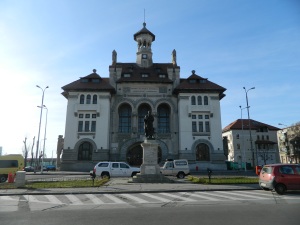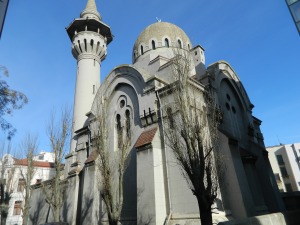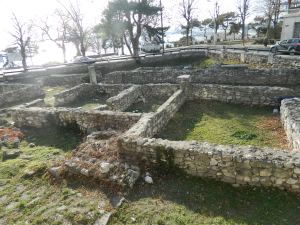Constanţa (ancient Greek colony Tomis) is the capital of Dobrogea region and Romania’s most important sea port. The city on the Black Sea coast reveals an attractive combination of Greco-Roman remains, Turkish mosques, Art Nouveau monuments and interesting museums. Constanţa is also an important starting point for going to the Romanian seaside resorts.
Top 5 Attractions
 Ovid Square (Piaţa Ovidiu) is dedicated to the Roman poet Ovid, who spent the last nine years of his life in Tomis, dying in exile in 17 A.D. Here you can visit the Archaeological and National History Museum (Muzeul de Istorie Naţională si Arheologie) , which has an excellent collection of statues of deities.Also you can admire here the unique representation of the Glykon Serpent.
Ovid Square (Piaţa Ovidiu) is dedicated to the Roman poet Ovid, who spent the last nine years of his life in Tomis, dying in exile in 17 A.D. Here you can visit the Archaeological and National History Museum (Muzeul de Istorie Naţională si Arheologie) , which has an excellent collection of statues of deities.Also you can admire here the unique representation of the Glykon Serpent.
 The Roman mosaic (Edificiul Roman cu Mozaic) is a building of approx. 700 sqm, which houses mosaic fragments discovered 5m below street level. It seems that the mosaic may have once decorated the upper hall of the Roman baths, whose outer walls can be seen from Canarache Alley.
The Roman mosaic (Edificiul Roman cu Mozaic) is a building of approx. 700 sqm, which houses mosaic fragments discovered 5m below street level. It seems that the mosaic may have once decorated the upper hall of the Roman baths, whose outer walls can be seen from Canarache Alley.
 Mahmudiye Mosque (Moscheea Mahmoud II), a copy of the mosque in Konya, Anatolia, is the biggest in Romania. It was built in 1910 for the Muslim community in Dobrogea. Here you can admire the huge indoor carpet, woven at the Hereke workshops in Istanbul, and enjoy the beautiful view offered by the 50 metres tall minaret.
Mahmudiye Mosque (Moscheea Mahmoud II), a copy of the mosque in Konya, Anatolia, is the biggest in Romania. It was built in 1910 for the Muslim community in Dobrogea. Here you can admire the huge indoor carpet, woven at the Hereke workshops in Istanbul, and enjoy the beautiful view offered by the 50 metres tall minaret.
 The Archaeological Park (Parcul Arheologic din Constanţa) exhibits outdoors the remains of Tomis city from the Roman – Byzantine period. You can also see the Roman city wall, which dates from the 3rd century AD and presents two gateways into the city. Do not miss the Butchers’ Tower (Turnul Măcelarilor), rebuilt during the rule of Emperor Justinian I the Great.
The Archaeological Park (Parcul Arheologic din Constanţa) exhibits outdoors the remains of Tomis city from the Roman – Byzantine period. You can also see the Roman city wall, which dates from the 3rd century AD and presents two gateways into the city. Do not miss the Butchers’ Tower (Turnul Măcelarilor), rebuilt during the rule of Emperor Justinian I the Great.
 The Orthodox Cathedral of St Peter and St Paul (Catedrala Ortodoxă “Sf. Petru si Pavel”), built between 1883 and 1885, is a mixture of Art – Nouveau, Neo – Byzantin and Romanian styles. Admire the beautiful carved iconostasis and the chandeliers and candlesticks made in Paris.
The Orthodox Cathedral of St Peter and St Paul (Catedrala Ortodoxă “Sf. Petru si Pavel”), built between 1883 and 1885, is a mixture of Art – Nouveau, Neo – Byzantin and Romanian styles. Admire the beautiful carved iconostasis and the chandeliers and candlesticks made in Paris.
Things to do
Talk a walk on the romantic promenade which runs along the waterfront. Here you can find the impressive Art – Nouveau Casino (built in 1909), considered to be the pearl of Constanta’s architecture, which functions as a restaurant and a bar.
At the entrance to the waterfront you can visit the Aquarium in Constanţa, which hosts a rich aquatic fauna consisting of exotic and native fish, species from the Black Sea coast, as well as migratory species from the Mediterranean Sea.
At the other end stands the Genoese Lighthouse (Farul Genovez), built in 1860 in memory of the Genoese merchants whose ships had crossed the waters of the Black Sea in the 12th – 14th centuries.
Visit the park around Lake Tăbăcăriei (Lacul Tăbăcăriei), located between Constanţa and Mamaia, in order not to miss a series of touristic attractions. The Dolphinarium, Planetarium and a collection of exotic birds are located in the south-eastern corner of the  park, while on the other bank of Lake Tăbăcăriei you can have fun in Satul de Vacanţă or the entertaining Luna Park.
park, while on the other bank of Lake Tăbăcăriei you can have fun in Satul de Vacanţă or the entertaining Luna Park.
An interesting event that you can attend is Navy Day (Ziua Marinei), celebrated annually on August 15th. The organized manifestations consist of demonstrative exercises, sailors’ games, boat contests and fireworks.


